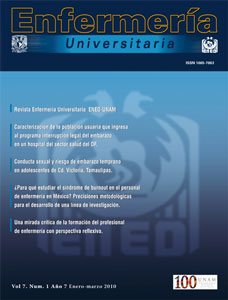Sexuality and practices of risk among adolescents in CD. Victora Tamps.
Main Article Content
Abstract
Introduction: The proportion of adolescents who have initiated sexual relations is increasing and they are beginning at an earlier age, nevertheless the ability to avoid pregnancy does not accompany this behavior. At the Sanitary Jurisdiction number 1,in Cd. Victoria, Tamaulipas; year 2008. they took care of 15,137 pregnant women, and of these, 22.0% are pregnancies in subjects who are younger than 20 years, affecting them in a considerable way in relation to life plans and the future of the adolescent mothers.
Objetive: The aim of this research was to describe the characteristics of the adolescent sexual behavior, variables related to the beginning of sexual activity and risk practices for pregnancy.
Methodology: A correlational, transversal, descriptive and observational study was carried out (Polit & Hungler, 1999) in adolescents of 12 to 19 years of age, both sexes, through a non-probabilistic sampling by availability, using an instrument with a Cronbach’s alpha of 0.82
Results: The sampling was of 1212, half of the cases are in the rank of 15 to 17 years and the mean is 16 years. 97% know about contraceptive methods but they do not know how they work. The information was acquired in school and from friends. 22% have active sexual life beginning between 14 and 15 years. They did not use a contraceptive method because the sexual relation was not planned. 50% have more than one couple. There was no association between age and the number of couples or between the age and the last time that they had sexual relations.
Discussion: The information that we obtained about sexual behavior do not differ from the one that was reported on the literature revision. Sexual activity begins earlier in men than in women. The use of contraceptive methods is not generalizable, neither in the first nor in the last sexual relation.
Conclusions: A high percentage do not know about contraceptive methods and how they work, considering these variables as a risk of pregnancy in adolescents.
Publication Facts
Reviewer profiles N/A
Author statements
- Academic society
- N/A
- Publisher
- Universidad Nacional Autónoma de México
Article Details
Dimensions citation
MÉTRICAS

This work is licensed under a Creative Commons Attribution-NonCommercial-NoDerivatives 4.0 International License.
Enfermería Universitaria by Universidad Nacional Autónoma de México it is distributed under the License Creative Commons Attribution - NonCommercial - NoDerivatives 4.0 International
Accepted and published articles become open-access under the terms of the Creative Commons CC BY-NC-ND 4.0 license, which authorizes the reproduction and sharing without commercial purposes, provided the corresponding acknowledgments to their authors. Authors are allowed to manage a self-archive copy of the article’s published version so that they can open-access it in their personal or institutional web pages, and/or any other broad-diffusion space.


